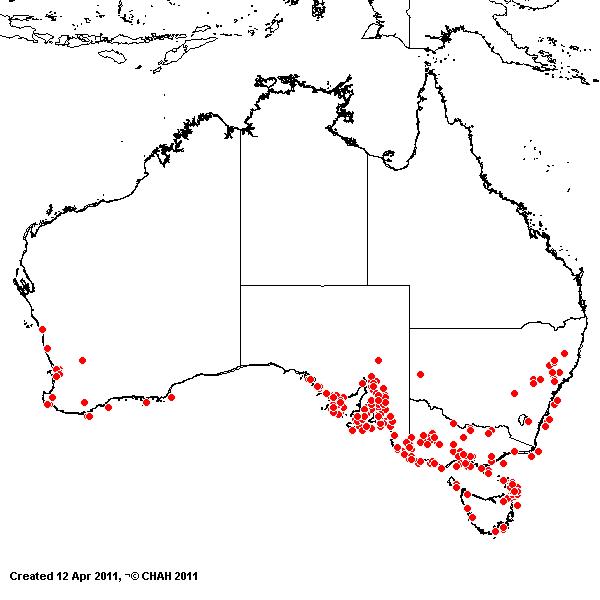Catapodium rigidum* (L.) C. E. Hubbard. Dony, Fl. Bedford. 437 (1953).
Classification. (GPWG 2001) : Subfamily Pooideae. Tribe Poeae.
Basionym and/or Replacement Name: Poa rigida L., Flora Anglica 10 (1754).
Type of Basionym or Protologue Information: LT: Bauhin, C., Prodr. icon. 6 (1620), LT designated by Stace in Cafferty et al., Taxon 49(2): 256 (2000).
LT: Anon., (LINN-87.37). LT designated by Stace & Jarvis, Bot. J. Linn. Soc. 91: 439 (1985), but this lectotypication is ineffective as the specimen is not original material [fide Cafferty et al., Taxon 49(2): 256 (2000)].
Recent synonyms: Desmaziera rigida, Scleropoa rigida.
Key references (books and floras): [1952] C.A.Gardner, Flora of Western Australia 1 Gramineae (99 as Scleropoa), [2002] D.Sharp & B.K.Simon, AusGrass, Grasses of Australia, [2002] J.Wheeler, N.Marchant & M.Lewington, Flora of the South West (406 as Desmazeria), [2006] J.Jessop, G.R.M.Dashorst, F.M.James, Grasses of South Australia (116), [2008] S.W.L.Jacobs, R.D.B.Walley & D.J.B.Wheeler, Grasses of New South Wales (196 as Desmazeria), [2009] A.Wilson (ed.). Flora of Australia, Vol 44A. Poaceae 2 (296).
Illustrations: [1952] C.A.Gardner, Flora of Western Australia 1 Gramineae (101, Pl.28), [2006] J.Jessop, G.R.M.Dashorst, F.M.James, Grasses of South Australia (117, fig. 76), [1984] N.T.Burbidge. rev. S.W.L.Jacobs, Australian Grasses (85), [2008] S.W.L.Jacobs, R.D.B.Whalley & D.J.B.Wheeler, Grasses of New South Wales, 4th edn (196 as Desmazeria rigidum), [2009]. A.Wilson (ed.), Flora of Australia 44A: Poaceae 2 (298, Fig. 40).
Habit. Annual. Culms erect or geniculately ascending, 2–34 cm tall, 2–5 -noded. Ligule an eciliate membrane, 1–3 mm long, obtuse. Leaf-blades flat, 1–15(–27) cm long, 0.5–4.7 mm wide. Leaf-blade surface scaberulous.
Inflorescence. Inflorescence compound, a panicle of racemes. Panicle linear or lanceolate or elliptic or ovate, dense or loose, 1–10 cm long, 0.5–2.5 cm wide.
Spikelets. Spikelets pedicelled. Fertile spikelets many flowered, with at least 2 fertile florets (3–10), comprising 3–10 fertile floret(s), with diminished florets at the apex, oblong, laterally compressed, 3.8–10.2 mm long.
Glumes. Glumes dissimilar. Lower glume lanceolate, coriaceous, keeled, 1-keeled, 1–3 -nerved. Upper glume elliptic, 1.3–2.2 mm long, coriaceous, keeled, 1-keeled, 1–3 -nerved.
Florets. Fertile lemma 1.8–3 mm long, without keel, 5 -nerved. Lemma surface glabrous. Palea 2 -nerved. Anthers 3.
Continental Distribution: Europe, Africa, Temperate Asia, Australasia, and South America.
Australian Distribution: Western Australia, South Australia, New South Wales, Victoria, Tasmania, Norfolk I, Lord Howe.
Western Australia: Drummond, Eyre, Avon. South Australia: Flinders Ranges, Eyre Peninsula, Northern Lofty, Murray, Yorke Peninsula, Southern Lofty, Kangaroo Island, South-eastern. New South Wales: North Coast, Central Coast, Northern Tablelands, North-Western Slopes, South-Western Slopes, North Far Western Plains. Victoria: East Gippsland, Gippsland Plain, Grampians, Lowan Mallee, Midlands, Murray Mallee, Otway Plain, Otway Range, Wilsons Promontory, Riverina, Volcanic Plain, Wannon, Wimmera. Tasmania: King Island, Furneaux Group, East Coast.
Notes. Introduced. Native in Europe and the Mediterranean, including north Africa, introduced to the Americas and southern Africa. In dry habitats, often sand or sandy soil, often coastal. Flowers July-Nov. Fruits Nov.-Mar.




